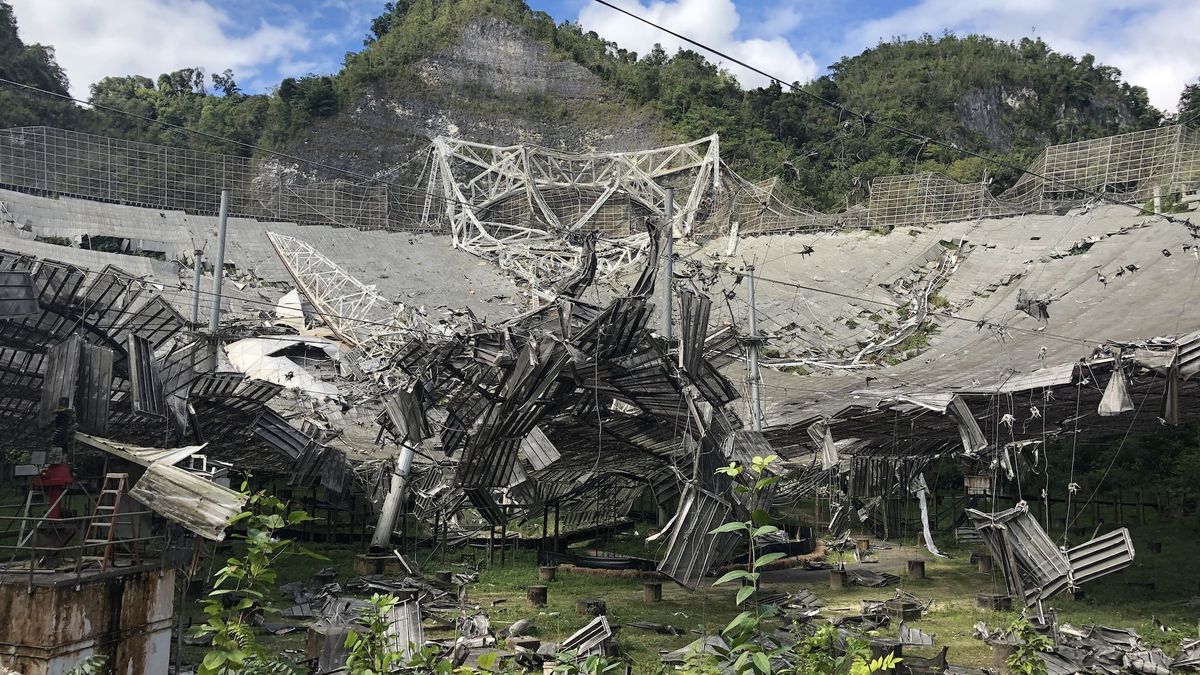The dramatic 2020 collapse of the famous Arecibo Telescope was 39 months in the making, according to a new federal report.
The just-released National Academy of Sciences, Engineering, and Medicine report found an “alarming” lack of documented concern about the telescope’s safety and stability after it was damaged by Hurricane Maria in 2017. It also found that the failure of the cables that ultimately snapped, leading to the telescope’s demise, could be traced to the sockets that held the cables in place.
The Arecibo Observatory is a National Science Foundation facility in Puerto Rico. The observatory’s key instrument, the 1,000-foot (305-meter) diameter Arecibo radio telescope, was completed in 1963 and was the largest single-aperture telescope in the world until 2016, when China’s FAST telescope surpassed it. The search for extraterrestrial intelligence was a key part of the telescope’s mission, and it broadcast Earth’s first attempt to contact extraterrestrials — now known as the “Arecibo Message” — in 1974.
But on Dec.1, 2020, the telescope collapsed with a sudden snapping of cables. At the time, operators had already decommissioned the telescope after earlier cable failures in August and November damaged critical parts of the observatory. But the new report finds that the initial trouble began well before that year.
Category 4 Hurricane Maria, which made landfall on Puerto Rico on Sept. 20, 2017, subjected the telescope to the highest wind loads it had ever experienced, the report’s authors found. Soon after, inspections revealed that some of the cables holding up the telescope had slipped from their sockets, but this failed to raise serious concerns, the committee tasked with investigating the failure wrote in the report.
Related: Collapsed Arecibo telescope offers near-Earth asteroid warning from beyond the grave
This may have been because the loads on the cables were still considered to be within a safe range, and because the type of socket connections at Arecibo had not been a point of failure in similar cables in the past.
“The Arecibo Telescope gave fair warning post-Maria that it was in structural distress through increasing cable socket pullout,” the report authors wrote. “Upon reflection, the unusually large and progressive cable pullouts of key structural cables that could be seen during visual inspection several months and years before the [2020 failure] should have raised the highest alarm level, requiring urgent action.”
However, there was no clear guidance for operators regarding when to raise alarms about structural stability, the report’s authors found: Each telescope upgrade added new structures and equipment, but there were not sufficient updates to the operating instructions and manuals covering how to properly maintain these additions.
The failure may have also stemmed from an unexpected weakness in the zinc connectors that held up the telescope cables, the report’s authors warned.
“There are no previous reports of such spelter socket failure in more than a century of their use,” the committee wrote. The only explanation the committee could come up with was that perhaps the strength of the electromagnetic radiation at a telescope the size of Arecibo may have weakened the sockets over many decades. That might have implications for the construction and maintenance of other large radio telescopes, the team wrote.
The investigation also indicated that it was pure luck that the telescope’s failures occurred at a time of day when no staff or visitors were in danger.
“The consequences of a structural failure of the Arecibo Telescope were not seriously considered in decision-making during design and operation or in extending the telescope’s life,” the committee concluded. “In particular, there was no formal consideration that the health and safety of the workers and the public were at risk in the event of a structural failure.”
